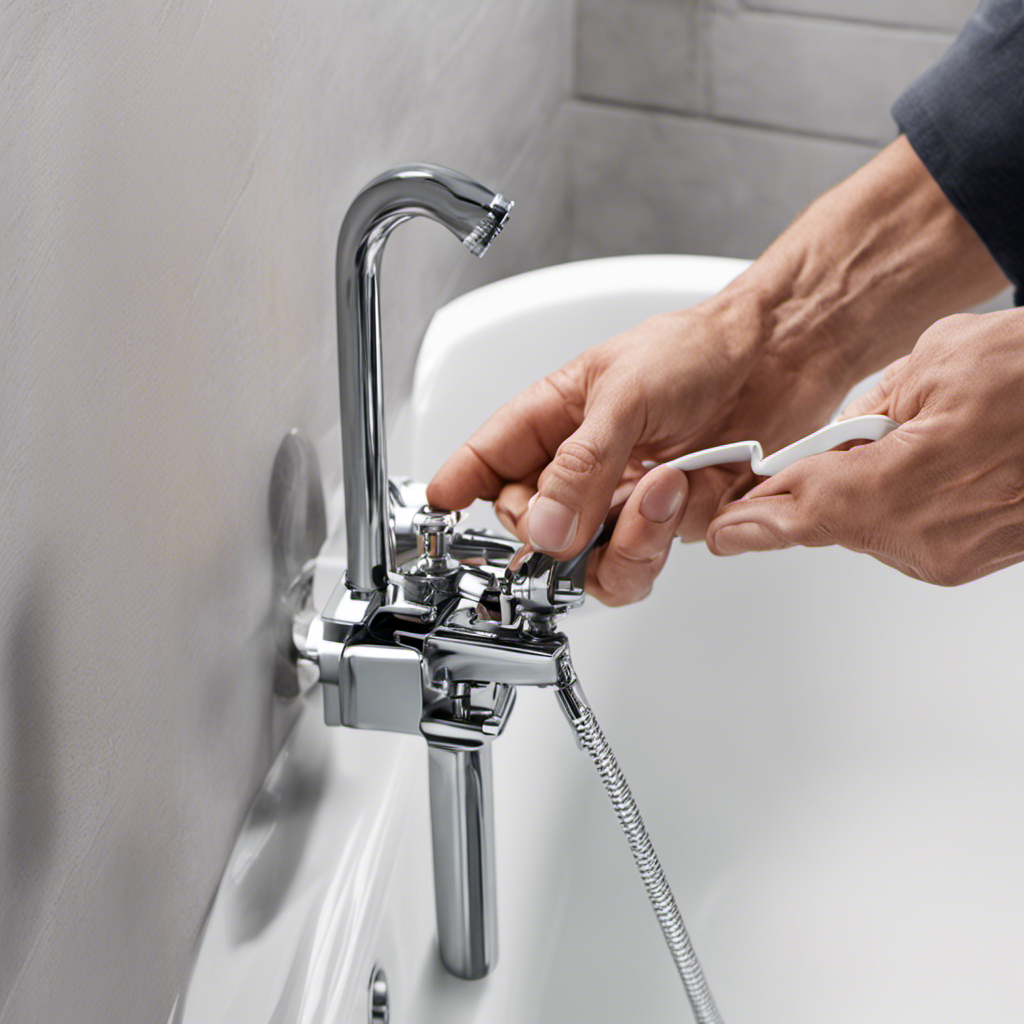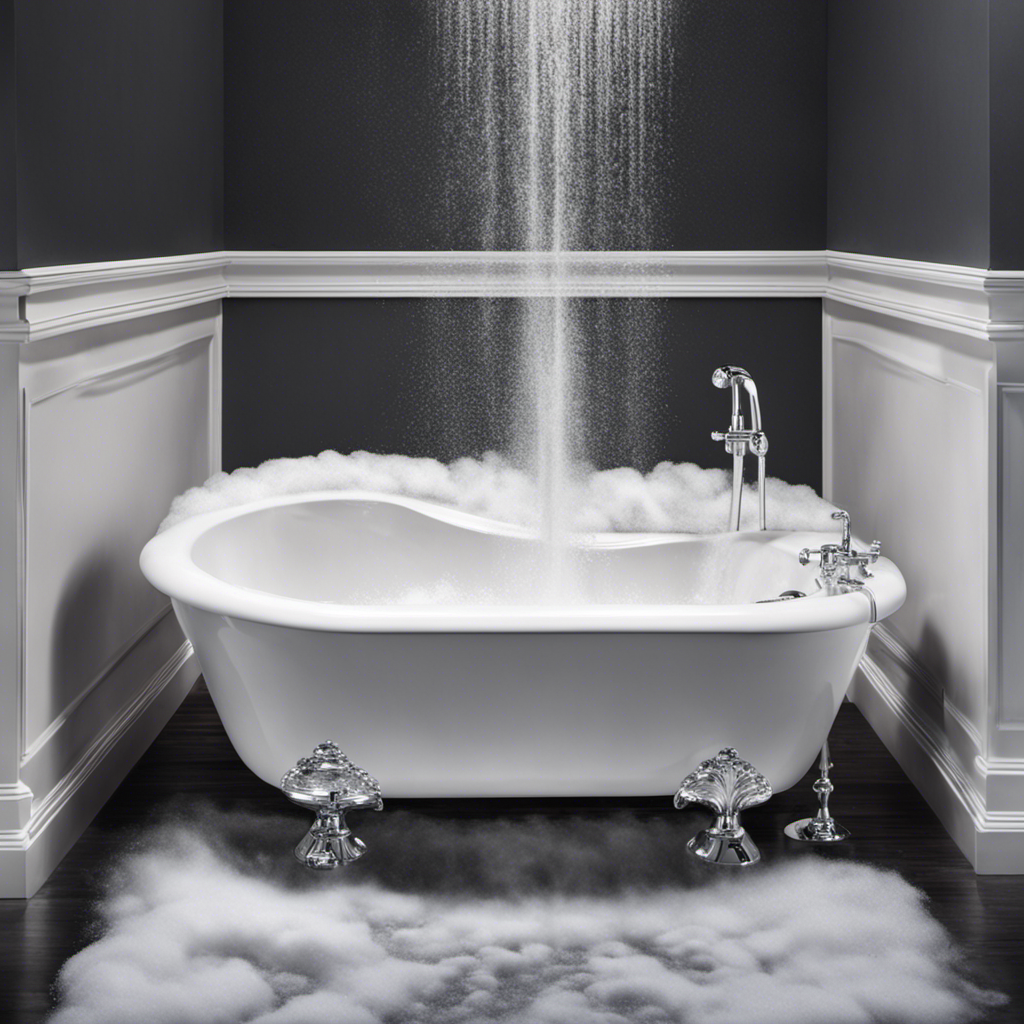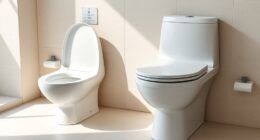Are you prepared for a power outage?
Picture this: the lights go out, leaving you in complete darkness. Suddenly, you realize you have no running water.
But fear not! There’s a simple solution: fill your bathtub with water.
In this article, we will explore the importance of having water during power outages, the benefits of filling your bathtub, and how to properly store and use this water in emergencies.
Stay informed and be ready for any situation that comes your way.
Key Takeaways
- Having water in the bathtub during a power outage is essential for reliable access to water for drinking, cooking, and personal hygiene.
- It is important to prepare for potential water supply disruptions during power outages by filling the bathtub with water before the outage, stocking up on bottled water, and considering alternative methods for personal hygiene.
- Filling the bathtub with water can provide emergency water supply for flushing toilets, washing dishes, and bathing, as well as emergency water filtration if necessary.
- Safety precautions should be taken when filling the bathtub with water, such as cleaning the bathtub thoroughly, using clean and potable water, avoiding contaminants, and ensuring the water level does not overflow.
Importance of Water During Power Outages
You’ll want to fill your bathtub with water during a power outage because it’s important to have a reliable source of water when the taps stop working.
In the event of a power outage, there is a potential water shortage due to the disruption of the water supply system. This can be a serious issue, especially if the outage lasts for an extended period.
By filling your bathtub with water beforehand, you ensure that you have access to a limited but essential supply of water for drinking, cooking, and personal hygiene.
It is crucial to conserve this water as much as possible to make it last longer. Use it wisely and consider using alternative methods for personal hygiene, such as wet wipes or hand sanitizers, to further conserve water during a power outage.
Potential Water Supply Disruptions During Power Outages
Make sure to prepare for potential disruptions to your water supply when the power goes out. During a power outage, there is a possibility of a potential water shortage, leaving you without access to running water. To ensure you have an emergency water supply, consider the following:
-
Fill your bathtub with water before the power goes out. This can provide you with a reserve of water for essential needs like flushing toilets or cleaning.
-
Stock up on bottled water to have on hand in case of an extended power outage.
-
Purchase a water storage container specifically designed for emergency situations.
-
Consider installing a backup generator to help maintain water supply during power outages.
Benefits of Filling the Bathtub With Water
To maximize your emergency water supply, remember to store water in your tub beforehand.
Filling your bathtub with water during a power outage can provide several benefits.
First, the water in your tub can be used for various purposes, such as flushing toilets, washing dishes, and even bathing. It can also be used for emergency water filtration if necessary. However, keep in mind that the water in your tub is not suitable for drinking unless it has been properly treated.
Additionally, the water in your tub can be used to maintain an optimal water temperature for certain medical conditions or for comfort during a power outage.
How Much Water Should Be Filled in the Bathtub
When filling the bathtub with water during a power outage, it is important to consider the optimal water level. You should aim to fill the tub to a level that is high enough to provide an adequate supply of water, but not so high that it risks overflowing.
Additionally, it is crucial to take safety precautions to prevent overflow, such as monitoring the water level and using a drain plug or towel to stop the water if necessary.
Lastly, you should also consider the duration of water supply that you may need during the outage and fill the bathtub accordingly.
Optimal Water Level
The optimal water level in the bathtub during a power outage is typically about halfway full. This ensures that you have enough water for essential tasks like drinking, cooking, and hygiene, without wasting too much water.
Here are some reasons why maintaining this water level is important:
- Provides enough water for basic needs during an outage.
- Ensures easy access to water without the need for additional containers.
- Reduces the risk of water spills or accidents.
- Allows for better control of the water temperature.
In addition to filling the bathtub, it is also recommended to have water storage containers on hand to supplement your water supply. These containers should be clean and properly sealed to prevent contamination. Remember to regularly check and replace the water to ensure its freshness and usability.
Safety Precautions for Overflow
Having too much water in the tub during a blackout can pose safety risks.
To prevent overflow, there are a few safety measures you can take. First, be cautious when filling the tub and ensure that the water level does not exceed the overflow drain, as this can cause flooding and damage to your bathroom.
Second, avoid leaving the tub unattended while it is filling up to prevent accidental overflow. It’s also a good idea to keep an eye on the water level and periodically check it to ensure it is not reaching dangerous levels.
By following these safety measures, you can prevent overflow and ensure the safety of your home during a power outage.
When considering the duration of water supply, it’s important to note that the water in the tub is not meant for long-term use. It is primarily intended for short-term needs, such as flushing toilets or basic hygiene.
Duration of Water Supply?
To ensure an adequate water supply during a blackout, you should be aware of the duration of the water available in the tub. Here are some key points to consider:
- The duration of water storage in the tub depends on its size and the water level you fill it to.
- A standard-sized tub can hold around 40 to 60 gallons of water.
- On average, a person uses about 80 to 100 gallons of water per day for drinking, cooking, and hygiene purposes.
- If you conserve water and use it sparingly, the water in the tub can last for a few days.
Understanding the duration of water storage in the tub is crucial for planning and rationing your water supply during a blackout.
Now, let’s move on to the next section where we will discuss safety precautions for filling the bathtub with water.
Safety Precautions for Filling the Bathtub With Water
Make sure you’re taking safety precautions when filling the bathtub with water during a power outage. It’s important to ensure that the water you store is safe for use in case of emergencies. Here are some safety measures you can take:
| Safety Precautions | Description |
|---|---|
| Cleanliness | Clean the bathtub thoroughly before filling it. |
| Water Source | Use clean, potable water from a reliable source. |
| Contamination | Avoid letting any contaminants enter the water. |
Alternative Uses for Bathtub Water During Power Outages
Did you know that you can use the water in your bathtub for other purposes during a power outage? Here are some alternative uses for bathtub water that can help you conserve and make the most of your water supply:
-
Flushing toilets: Use a bucket to pour water from the bathtub into the toilet bowl to manually flush.
-
Cleaning: Use the water to clean dishes, utensils, or even yourself if necessary.
-
Watering plants: Give your plants a drink by using the water from the bathtub.
-
Pets: Use the water to give your furry friends a bath or to fill their water bowls.
By utilizing these alternative uses for bathtub water, you can conserve your water supply and make it last longer during a power outage.
Speaking of water supply, let’s now discuss the duration of water supply when filled in the bathtub.
Duration of Water Supply When Filled in the Bathtub
During a power outage, it’s important to be mindful of your water usage. You may need to rely on alternative water storage, such as filling the bathtub, to ensure you have enough water for essential tasks.
However, it’s crucial to consider the safety of stored water and take necessary precautions to prevent contamination.
Water Usage During Outage
Remember to conserve water during the power outage by using the stored water in your filled bathtub for essential tasks. This will help you minimize water usage and make the most of your limited supply.
Here are some water conservation tips to keep in mind:
- Use a bucket to collect rainwater for flushing toilets or watering plants.
- Limit showers to a few minutes and avoid leaving the water running while brushing your teeth.
- Wash dishes and do laundry only when necessary, using full loads.
- Consider using hand sanitizer instead of washing your hands with water.
During a power outage, it’s important to be mindful of potential water contamination. If you suspect your water supply may be compromised, avoid drinking or using tap water until it has been deemed safe.
Alternative Water Storage
To make the most of your limited supply, consider using alternative containers, such as large plastic jugs or buckets, to store water during the outage.
When facing a power outage, having access to clean water is essential for your safety and well-being. While filling the bathtub is a common practice, it may not always be the most efficient solution.
Alternative water storage containers can help you maximize your emergency water sources. Large plastic jugs or buckets can be easily filled and sealed to prevent contamination. They are also portable, allowing you to transport water to different areas of your home as needed.
Remember to label the containers with the date of filling and rotate the water every six months. These simple steps can ensure that you have a reliable water supply during an outage.
Safety of Stored Water
Having access to clean water is essential for your safety and well-being, so it’s important to ensure the safety of the water you have stored.
Here are some important tips to consider when storing water:
-
Choose the right containers: Use food-grade containers specifically designed for water storage. Avoid using containers that previously held chemicals or non-food items.
-
Regularly rotate your water supply: Stagnant water can become a breeding ground for bacteria and other contaminants. It’s recommended to rotate your water supply every six months.
-
Keep your water storage area clean: Regularly clean and sanitize your water storage containers and the area where they are stored. This helps prevent the growth of harmful bacteria.
-
Store water in a cool, dark place: Exposure to sunlight and heat can degrade the quality of stored water. Keep your water containers in a cool, dark area to maintain its freshness.
Tips for Conserving Water During a Power Outage
If you’re experiencing a power outage, one way to conserve water is by filling your bathtub.
During water supply disruptions, it’s important to be mindful of your water usage. By following a few simple tips, you can conserve water and ensure you have enough for essential needs.
Firstly, limit your showers to a few minutes and turn off the water while lathering.
Secondly, use a basin to wash dishes instead of letting the water run continuously.
Thirdly, only run the dishwasher and washing machine when they are full.
Lastly, fix any leaks in your faucets or toilets promptly to avoid wasting water.
How to Properly Store and Use Bathtub Water During Emergencies
When it comes to storing water in your bathtub during emergencies, it’s important to prioritize safety.
You should ensure that your bathtub is clean and free from any harmful substances before filling it with water.
Additionally, understanding the practical uses for this stored water can help you make the most out of this valuable resource during a crisis.
Water Storage Safety
To ensure water storage safety during a power outage, you should regularly sanitize your bathtub and cover it to prevent any contamination. Here are some tips to help you maintain a safe water supply:
- Clean your bathtub thoroughly before filling it with water for emergency use.
- Use water purification methods, such as boiling or using water purification tablets, to make the stored water safe to drink.
- Keep a siphon or a water filter handy for emergency water filtration.
- Use clean containers to collect and store rainwater for additional water supply.
By following these steps, you can ensure that your stored water remains safe and suitable for drinking during a power outage or other emergencies.
Now let’s explore the practical uses for water during such situations.
Practical Uses for Water
Remember, having access to clean water is essential in a power outage. You can use it for cooking, cleaning, and personal hygiene.
When the power goes out, practical uses for water become even more important. You can use the water you’ve stored in your bathtub for cooking meals, washing dishes, and even flushing the toilet.
It’s crucial to conserve water during a power outage, as you may not know when your supply will be restored. By using your bathtub water wisely, you can make it last longer and ensure you have enough for your essential needs.
However, if you need additional water storage options, there are other alternatives to consider.
Other Water Storage Options for Power Outages
There are alternative options for storing water during a power outage. Instead of relying solely on filling your bathtub, here are some other options to consider:
-
Use large containers: Fill up large containers, such as clean jugs or buckets, with water before the power goes out. These can serve as additional sources of water for drinking and sanitation purposes.
-
Purchase water storage containers: Invest in water storage containers specifically designed for emergencies. These containers are usually made from durable materials and have airtight seals to keep the water clean and safe to use.
-
Utilize rainwater harvesting: Set up a rainwater collection system to capture and store rainwater for future use. This can be a sustainable alternative water source during a power outage.
-
Explore water conservation tips: Incorporate water conservation practices into your daily routine, such as taking shorter showers, fixing leaks, and using dishwashers and washing machines only when they are full.
Frequently Asked Questions
How Long Does It Take for the Water in the Bathtub to Become Unsafe for Drinking During a Power Outage?
It takes a few hours for bathtub water to become unsafe for drinking during a power outage. To ensure safety, consider using water purification options or other safety measures.
Can I Use the Water in the Bathtub to Flush the Toilet During a Power Outage?
During a power outage, you can use the water in your bathtub to flush the toilet. It’s a clever way to conserve water. Plus, you can also use it for cleaning dishes and doing laundry.
Are There Any Risks Associated With Using the Water in the Bathtub for Bathing or Washing Dishes During a Power Outage?
Using bathtub water for hygiene during a power outage can pose risks. The lack of power may affect the water quality, making it unsafe for bathing or washing dishes. Be cautious to prevent any potential health issues.
What Are the Alternative Options for Storing Water if I Don’t Have a Bathtub?
If you don’t have a bathtub, there are still alternatives for storing water during a power outage. Consider rainwater harvesting or using water storage containers to ensure you have access to clean water.
Can I Use the Water in the Bathtub for Watering Plants or Pets During a Power Outage?
During a power outage, you can use the water in your bathtub for gardening or cleaning. It’s a convenient option if you don’t have access to running water. Just make sure to use it wisely.
Conclusion
So, there you have it! Filling your bathtub with water during a power outage is like having a hidden treasure chest in your home. It’s a smart move that ensures you’ll have a reserve of clean water to use for drinking, cooking, and hygiene when the taps run dry.
Just imagine, a bathtub full of water is like a lifeline, a beacon of hope in the darkness. So, don’t forget to fill that tub and be prepared for any power outage that comes your way.
Stay safe and stay hydrated!










